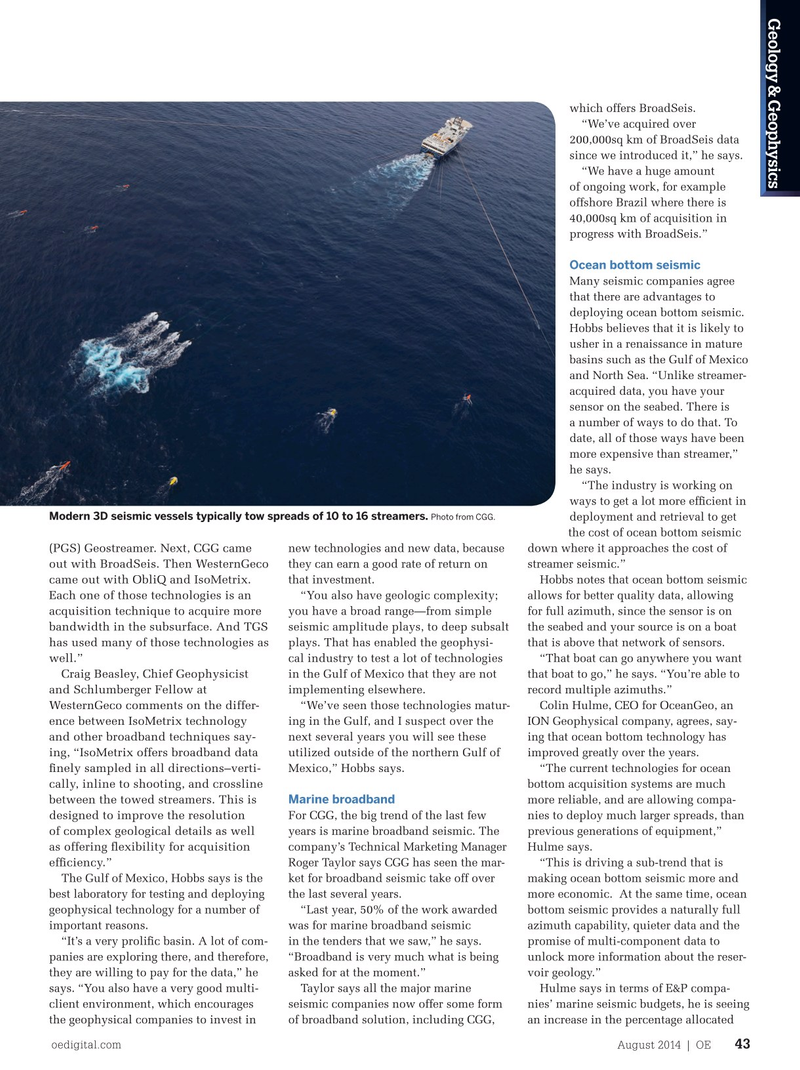
Page 41: of Offshore Engineer Magazine (Aug/Sep 2014)
Read this page in Pdf, Flash or Html5 edition of Aug/Sep 2014 Offshore Engineer Magazine
Geology & Geophysics which offers BroadSeis. “We’ve acquired over 200,000sq km of BroadSeis data since we introduced it,” he says. “We have a huge amount of ongoing work, for example
Trending upward offshore Brazil where there is 40,000sq km of acquisition in progress with BroadSeis.”
Ocean bottom seismic
Many seismic companies agree that there are advantages to deploying ocean bottom seismic.
Hobbs believes that it is likely to usher in a renaissance in mature basins such as the Gulf of Mexico and North Sea. “Unlike streamer- acquired data, you have your sensor on the seabed. There is a number of ways to do that. To date, all of those ways have been more expensive than streamer,” he says. “The industry is working on ways to get a lot more effcient in
Modern 3D seismic vessels typically tow spreads of 10 to 16 streamers. Photo from CGG.
deployment and retrieval to get the cost of ocean bottom seismic (PGS) Geostreamer. Next, CGG came new technologies and new data, because down where it approaches the cost of out with BroadSeis. Then WesternGeco they can earn a good rate of return on streamer seismic.” came out with ObliQ and IsoMetrix. that investment. Hobbs notes that ocean bottom seismic
Each one of those technologies is an “You also have geologic complexity; allows for better quality data, allowing acquisition technique to acquire more you have a broad range—from simple for full azimuth, since the sensor is on bandwidth in the subsurface. And TGS seismic amplitude plays, to deep subsalt the seabed and your source is on a boat has used many of those technologies as plays. That has enabled the geophysi- that is above that network of sensors. well.” cal industry to test a lot of technologies “That boat can go anywhere you want
Craig Beasley, Chief Geophysicist in the Gulf of Mexico that they are not that boat to go,” he says. “You’re able to and Schlumberger Fellow at implementing elsewhere. record multiple azimuths.”
WesternGeco comments on the differ- “We’ve seen those technologies matur- Colin Hulme, CEO for OceanGeo, an ence between IsoMetrix technology ing in the Gulf, and I suspect over the ION Geophysical company, agrees, say- and other broadband techniques say- next several years you will see these ing that ocean bottom technology has ing, “IsoMetrix offers broadband data utilized outside of the northern Gulf of improved greatly over the years.
fnely sampled in all directions–verti-
Mexico,” Hobbs says. “The current technologies for ocean cally, inline to shooting, and crossline bottom acquisition systems are much between the towed streamers. This is
Marine broadband more reliable, and are allowing compa-
For CGG, the big trend of the last few nies to deploy much larger spreads, than designed to improve the resolution data and that several companies offer years is marine broadband seismic. The previous generations of equipment,” of complex geological details as well their own technology to do it. company’s Technical Marketing Manager Hulme says. as offering fexibility for acquisition “You can either process more band- Roger Taylor says CGG has seen the mar- “This is driving a sub-trend that is effciency.” widths out of conventionally acquired The Gulf of Mexico, Hobbs says is the ket for broadband seismic take off over making ocean bottom seismic more and seismic streamer data, and that’s what we best laboratory for testing and deploying the last several years. more economic. At the same time, ocean do at TGS; we have our own technology geophysical technology for a number of “Last year, 50% of the work awarded bottom seismic provides a naturally full to take conventionally acquired seismic important reasons. was for marine broadband seismic azimuth capability, quieter data and the data and extract broader bandwidth out “It’s a very prolifc basin. A lot of com- in the tenders that we saw,” he says. promise of multi-component data to of that data. panies are exploring there, and therefore, “Broadband is very much what is being unlock more information about the reser- “You have a number of companies they are willing to pay for the data,” he asked for at the moment.” voir geology.” that are offering technologies that are says. “You also have a very good multi- Taylor says all the major marine Hulme says in terms of E&P compa- acquisition-based. The frst one to client environment, which encourages seismic companies now offer some form nies’ marine seismic budgets, he is seeing come out was Petroleum Geo-Services’ the geophysical companies to invest in of broadband solution, including CGG, an increase in the percentage allocated oedigital.com August 2014 | OE 43 042_OE0814_G&G1.indd 43 7/22/14 5:37 PM

 40
40

 42
42